List of National Historic Sites of Canada in Niagara Region
This is a list of National Historic Sites of Canada (French: Lieux historiques nationaux du Canada) in Niagara Region, Ontario. There are 26 National Historic Sites designated in Niagara,[1] of which nine are administered by Parks Canada (identified below by the beaver icon ![]() ).[2]
).[2]
National Historic Sites located elsewhere in Ontario are listed at List of National Historic Sites of Canada in Ontario.
This list uses the designation names as recognized by the Historic Sites and Monuments Board of Canada, not necessarily the official or colloquial names of the sites.
National Historic Sites
![]() Media related to National Historic Sites of Canada in Ontario at Wikimedia Commons
Media related to National Historic Sites of Canada in Ontario at Wikimedia Commons
| Site | Date(s) | Designated | Location | Description | Image |
|---|---|---|---|---|---|
| Battle of Beaver Dams [3][4] | 1813 (battle) | 1921 | Thorold 43°07′04″N 79°11′08″W / 43.117776°N 79.185419°W |
The site of a decisive British victory during the War of 1812, after heroine Laura Secord had earlier struck out on a long and difficult trek to warn the British of an impending American attack |  |
| Battle of Chippawa [5][6] | 1814 (battle) | 1921 | Chippawa 43°03′08″N 79°01′29″W / 43.052127°N 79.024720°W |
The site of a battle that took place during the War of 1812 as a result of the last major American invasion of Canada | 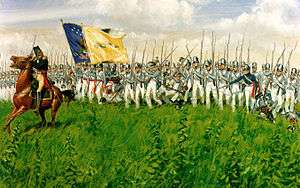 |
| Battle of Cook's Mills |
1814 (battle) | 1921 | Cooks Mills 42°59′52″N 79°10′30″W / 42.997895°N 79.174913°W |
The site of the last engagement between U.S. and British/Canadian armies fought in Niagara, and second-last on Canadian soil during the War of 1812 | 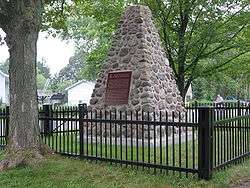 |
| Battle of Lundy's Lane [9][10] | 1814 (battle) | 1937 | Niagara Falls 43°05′21″N 79°05′44″W / 43.089152°N 79.095456°W |
The site of a spontaneous confrontation between the British and American forces in which the British attacked American forces returning from the Battle of Chippawa; the six-hour-long battle was one of the bloodiest battles of the War of 1812 and marked the end of American offensive in Upper Canada | 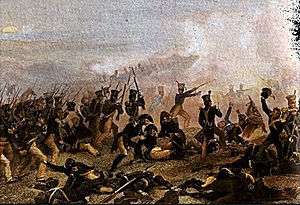 |
| Battlefield of Fort George |
1813 (battle) | 1921 | Niagara-on-the-Lake 43°15.722′N 79°05.071′W / 43.262033°N 79.084517°W |
The site of one of the fiercest battles of the War of 1812, in which the U.S. managed to gain a toehold on the Niagara Peninsula; distinct from nearby Fort George National Historic Site | |
| Butler's Barracks |
1814–54 (completed) | 1963 | Niagara-on-the-Lake 43°14′54″N 79°04′27″W / 43.248370°N 79.074044°W |
A complex of five wooden buildings, built by the British after the War of 1812 and occupied as a military camp until the 1960s, representing 150 years of military history | |
| Former L.J. Shickluna Service Station [15][16] | 1924 (c.) (completed) | 1995 | Port Colborne 42°53′17″N 79°15′04″W / 42.887941°N 79.251214°W |
Early Spanish Colonial Revival-style service station; symbol of rapid post-World War I automobile culture | |
| Fort Drummond [17][18] | 1814 (completed) | 1928 | Niagara-on-the-Lake 43°09′37″N 79°03′08″W / 43.160147°N 79.052234°W |
A redoubt and battery constructed during the War of 1812 to protect the main portage road from Chippawa to Queenston, named after Sir Gordon Drummond; some walls of the redoubt are still extant | |
| Fort Erie [19][20] | 1808 (completion of third Fort Erie) | 1933 | Fort Erie (town) 42°53′35.70″N 78°55′25.74″W / 42.8932500°N 78.9238167°W |
The first British fort to be constructed as part of a network developed after the Seven Years' War in the western portion of the Province of Quebec (later Upper Canada); captured and destroyed in 1814 by invading American forces during the War of 1812, the remains of the fort were rebuilt by the Niagara Parks Commission in 1937–39 | |
| Fort George |
1799 (completed), 1940 (reconstruction completed) | 1921 | Niagara-on-the-Lake 43°15′03″N 79°03′40″W / 43.25083°N 79.06111°W |
Reconstructed British fort that served as the principal fortification on the Niagara Peninsula during the War of 1812; distinct from the nearby Battlefield of Fort George National Historic Site | |
| Fort Mississauga |
1814 (completed) | 1960 | Niagara-on-the-Lake 43°15′42″N 79°04′36″W / 43.26167°N 79.07667°W |
Located in a strategic position at the mouth of the Niagara River to protect the Canadian frontier and to counter Fort Niagara on the U.S. side, it is the only remaining fortification of its type (a square tower within a star-shaped earthwork) in Canada | 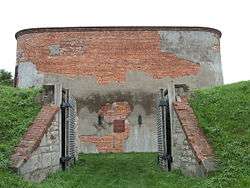 |
| Frenchman's Creek [25][26] | 1812 (battle) | 1921 | Fort Erie 42°56′32″N 78°55′35″W / 42.94227°N 78.92645°W |
The battle of Frenchman’s Creek was a minor skirmish in the War of 1812, where British forces pushed an American advance parties back across the Niagara River; the failure of American troops contributed, in part, to the cancellation of the larger invasion planned for the Niagara peninsula at the end of 1812 |  |
| Mississauga Point Lighthouse |
1804 (completed), 1814 (demolished) | 1937 | Niagara-on-the-Lake 43°15′41.92″N 79°4′35.86″W / 43.2616444°N 79.0766278°W |
The first lighthouse on the Great Lakes, constructed in 1804 by the military masons of the 49th Regiment of Foot, it was damaged in the Battle of Fort George in 1813, and demolished in 1814 when the British built Fort Mississauga on the site | |
| Navy Island |
1761 (shipyard established) | 1921 | Niagara Falls 43°3′23.07″N 79°0′38.1″W / 43.0564083°N 79.010583°W |
Archaeological remains on an uninhabited island on the Ontario side of the Niagara River; during the 1760s, the island was home to the first British shipyard to serve the Upper Great Lakes and, during the Upper Canada Rebellion, the seat of William Lyon Mackenzie’s exiled government, the Republic of Canada | 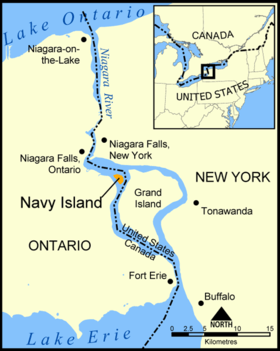 |
| Niagara Apothecary [31][32] | 1820 (completed) | 1968 | Niagara-on-the-Lake 43°15′18.25″N 79°4′15.3″W / 43.2550694°N 79.070917°W |
A white, single-storey clapboard Georgian building on Niagara-on-the-Lake’s main commercial street, it served as an apothecary/pharmacy from approximately 1866 to 1964 and it is one of the very few remaining examples of an old apothecary shop |  |
| Niagara District Court House [33][34] | 1847 (completed) | 1980 | Niagara-on-the-Lake 43°15′18.25″N 79°4′15.3″W / 43.2550694°N 79.070917°W |
Designed by William Thomas in the Neoclassical style, it is an excellent example of a mid-19th-century multipurpose civic structure, originally containing the local court house, jail, market and town hall |  |
| Niagara-on-the-Lake [35][36] | 1815–59 (completed) | 2003 | Niagara-on-the-Lake 43°15′18.02″N 79°4′18.6″W / 43.2550056°N 79.071833°W |
An early-19th-century Loyalist town located on the southern shore of Lake Ontario; the historic district covers 25 city blocks and contains the best collection of buildings in Canada from the period following the War of 1812 | 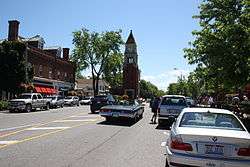 |
| Point Abino Light Tower [37][38] | 1918 (completed) | 1998 | Crystal Beach 42°50′7.85″N 79°5′42.64″W / 42.8355139°N 79.0951778°W |
A lighthouse situated at the eastern end of Lake Erie; intended to complement the summer homes nearby, it was more elaborately designed than most Canadian lighthouses, with a high level of its features still intact | |
| Queenston Heights |
1812 (battle) | 1968 | Niagara-on-the-Lake 43°09′37″N 79°03′08″W / 43.160147°N 79.052234°W |
A treed promontory on the Niagara Escarpment, where the British repulsed an American invasion in the Battle of Queenston Heights in the War of 1812; site of Brock's Monument and a monument to Laura Secord |  |
| Queenston-Chippawa Hydro-electric Plant [41][42] | 1925 (completed) | 1990 | Niagara-on-the-Lake 43°8′45.47″N 79°2′43.55″W / 43.1459639°N 79.0454306°W |
At the time of its completion, it was the first large-scale hydroelectric generation project in the world | 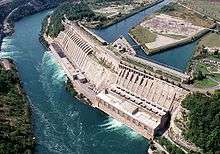 |
| R. Nathaniel Dett British Methodist Episcopal Church [43][44] | 1836 (completed) | 1999 | Niagara Falls 43°5′16.1″N 79°5′14.95″W / 43.087806°N 79.0874861°W |
A British Methodist Episcopal Church chapel named after and associated with the formative years of composer Robert Nathaniel Dett; representative of early black settlement in the Niagara area and the church's role in assisting Underground Railroad refugees |  |
| Ridgeway Battlefield |
1866 (battle) | 1921 | Fort Erie 42°54′16″N 79°02′30″W / 42.904349°N 79.041642°W |
The site of the battlefield where the Queen’s Own Rifles, 13th Hamilton Battalion, and Caledonia and York Rifle Companies of Haldimand defended Canada against Fenian raiders from the United States | 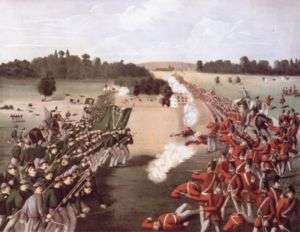 |
| Salem Chapel, British Methodist Episcopal Church [47][48] | 1855 (completed) | 1999 | St. Catharines 43°9′54.71″N 79°14′24.16″W / 43.1651972°N 79.2400444°W |
A gable-fronted church representative of the auditory-hall design of Underground Railroad-related churches; an important centre of 19th-century abolitionist activity in Canada, associated with Harriet Tubman | 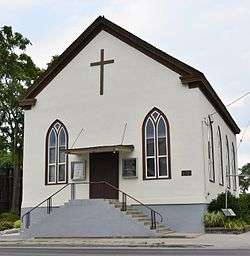 |
| Toronto Power Generating Station [49][50] | 1913 (completed) | 1983 | Niagara Falls 43°4′19.45″N 79°4′25.74″W / 43.0720694°N 79.0738167°W |
A generating station to supply hydro-electric power to Toronto, it was the first wholly Canadian-owned hydro-electric facility at Niagara Falls; an elegant and unusual application of Beaux-Arts design to an industrial site in Canada |  |
| Willowbank [51][52] | 1836 (completed) | 2003 | Niagara-on-the-Lake 43°10′04″N 79°03′29″W / 43.16773°N 79.05796°W |
A 5-hectare (12-acre) estate with a large three-and-a-half storey temple-fronted mansion; the landscaping and largely unchanged exterior architecture are symbolic of the fusion of Neoclassical architecture and the Picturesque ideal that characterized large country estates of Upper Canada in the early 19th century | 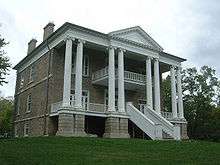 |
| Vrooman's Battery [53][54] | 1812 (battle) | 1921 | Niagara-on-the-Lake 43°10′41.76″N 79°3′30.05″W / 43.1782667°N 79.0583472°W |
An artillery battery that maintained a harassing fire on the American forces crossing the Niagara River during the Battle of Queenston Heights in the War of 1812; now consists of a mound on the riverbank | |
See also
| Wikimedia Commons has media related to National Historic Sites of Canada in Ontario. |
References
- ↑ Ottawa, Directory of Designations of National Historic Significance of Canada
- ↑ Niagara, Queenston, Cook's Mills, Ridgeway - National Historic Sites of Canada - administered by Parks Canada
- ↑ Battle of Beaver Dams, Directory of Designations of National Historic Significance of Canada
- ↑ Battle of Beaver Dams. Canadian Register of Historic Places.
- ↑ Battle of Chippawa, Directory of Designations of National Historic Significance of Canada
- ↑ Battle of Chippawa. Canadian Register of Historic Places.
- ↑ Battle of Cook's Mills, Directory of Designations of National Historic Significance of Canada
- ↑ Battle of Cook's Mills. Canadian Register of Historic Places.
- ↑ Battle of Lundy's Lane, Directory of Designations of National Historic Significance of Canada
- ↑ Battle of Lundy's Lane. Canadian Register of Historic Places.
- ↑ Battlefield of Fort George, Directory of Designations of National Historic Significance of Canada
- ↑ Battlefield of Fort George. Canadian Register of Historic Places.
- ↑ Butler's Barracks, Directory of Designations of National Historic Significance of Canada
- ↑ Butler's Barracks. Canadian Register of Historic Places.
- ↑ Former L.J. Shickluna Service Station, Directory of Designations of National Historic Significance of Canada
- ↑ Macfarlane, L.C. (Kate). "Gasoline Stations". The Canadian Encyclopedia. The Historica Dominion Institute. Retrieved 28 February 2011.
- ↑ Fort Drummond, Directory of Designations of National Historic Significance of Canada
- ↑ Fort Drummond. Canadian Register of Historic Places.
- ↑ Fort Erie, Directory of Designations of National Historic Significance of Canada
- ↑ Fort Erie. Canadian Register of Historic Places.
- ↑ Fort George, Directory of Designations of National Historic Significance of Canada
- ↑ Fort George. Canadian Register of Historic Places.
- ↑ Fort Mississauga, Directory of Designations of National Historic Significance of Canada
- ↑ Fort Mississauga. Canadian Register of Historic Places.
- ↑ Frenchman's Creek, Directory of Designations of National Historic Significance of Canada
- ↑ Frenchman's Creek. Canadian Register of Historic Places.
- ↑ Mississauga Point Lighthouse, Directory of Designations of National Historic Significance of Canada
- ↑ Mississauga Point Lighthouse. Canadian Register of Historic Places.
- ↑ Navy Island, Directory of Designations of National Historic Significance of Canada
- ↑ Navy Island. Canadian Register of Historic Places.
- ↑ Niagara Apothecary, Directory of Designations of National Historic Significance of Canada
- ↑ Niagara Apothecary. Canadian Register of Historic Places.
- ↑ Niagara District Court House, Directory of Designations of National Historic Significance of Canada
- ↑ Niagara District Court House. Canadian Register of Historic Places.
- ↑ Niagara-on-the-Lake, Directory of Designations of National Historic Significance of Canada
- ↑ Niagara-on-the-Lake. Canadian Register of Historic Places.
- ↑ Abino Light Tower, Directory of Designations of National Historic Significance of Canada
- ↑ Point Abino Light Tower. Canadian Register of Historic Places.
- ↑ Queenston Heights, Directory of Designations of National Historic Significance of Canada
- ↑ Queenston Heights. Canadian Register of Historic Places.
- ↑ Queenston-Chippawa Hydro-electric Plant, Directory of Designations of National Historic Significance of Canada
- ↑ Queenston-Chippawa Hydro-electric Plant. Canadian Register of Historic Places.
- ↑ R. Nathaniel Dett British Methodist Episcopal Church, Directory of Designations of National Historic Significance of Canada
- ↑ Nathaniel Dett British Methodist Episcopal Church. Canadian Register of Historic Places.
- ↑ Ridgeway Battlefield, Directory of Designations of National Historic Significance of Canada
- ↑ Ridgeway Battlefield. Canadian Register of Historic Places.
- ↑ Salem Chapel, British Methodist Episcopal Church, Directory of Designations of National Historic Significance of Canada
- ↑ Salem Chapel, British Methodist Episcopal Church. Canadian Register of Historic Places.
- ↑ Toronto Power Generating Station, Directory of Designations of National Historic Significance of Canada
- ↑ Toronto Power Generating Station. Canadian Register of Historic Places.
- ↑ Willowbank, Directory of Designations of National Historic Significance of Canada
- ↑ Willowbank. Canadian Register of Historic Places.
- ↑ Vrooman's Battery, Directory of Designations of National Historic Significance of Canada
- ↑ Vrooman's Battery. Canadian Register of Historic Places.
This article is issued from Wikipedia - version of the 11/19/2016. The text is available under the Creative Commons Attribution/Share Alike but additional terms may apply for the media files.